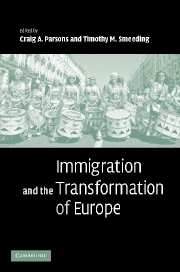Book contents
- Frontmatter
- Contents
- List of figures
- List of tables
- List of contributors
- Acknowledgements
- 1 What's unique about immigration in Europe?
- 2 Europe's immigration challenge in demographic perspective
- 3 Migration into OECD countries 1990–2000
- 4 Divergent patterns in immigrant earnings across European destinations
- 5 Economic consequences of immigration in Europe
- 6 Occupational status of immigrants in cross-national perspective: A multilevel analysis of seventeen Western societies
- 7 Immigrants, unemployment, and Europe's varying welfare regimes
- 8 How different are immigrants? A cross-country and cross-survey analysis of educational achievement
- 9 Immigration, education, and the Turkish second generation in five European nations: A comparative study
- 10 Managing transnational Islam: Muslims and the state in Western Europe
- 11 Migration mobility in European diasporic space
- 12 The new migratory Europe: Towards a proactive immigration policy?
- 13 European immigration in the people's court
- 14 The politics of immigration in France, Britain, and the United States: A transatlantic comparison
- 15 “Useful” Gastarbeiter, burdensome asylum seekers, and the second wave of welfare retrenchment: Exploring the nexus between migration and the welfare state
- 16 The European Union dimension: Supranational integration, free movement of persons, and immigration politics
- 17 The effectiveness of governments’ attempts to control unwanted migration
- Index
- References
16 - The European Union dimension: Supranational integration, free movement of persons, and immigration politics
Published online by Cambridge University Press: 23 June 2009
- Frontmatter
- Contents
- List of figures
- List of tables
- List of contributors
- Acknowledgements
- 1 What's unique about immigration in Europe?
- 2 Europe's immigration challenge in demographic perspective
- 3 Migration into OECD countries 1990–2000
- 4 Divergent patterns in immigrant earnings across European destinations
- 5 Economic consequences of immigration in Europe
- 6 Occupational status of immigrants in cross-national perspective: A multilevel analysis of seventeen Western societies
- 7 Immigrants, unemployment, and Europe's varying welfare regimes
- 8 How different are immigrants? A cross-country and cross-survey analysis of educational achievement
- 9 Immigration, education, and the Turkish second generation in five European nations: A comparative study
- 10 Managing transnational Islam: Muslims and the state in Western Europe
- 11 Migration mobility in European diasporic space
- 12 The new migratory Europe: Towards a proactive immigration policy?
- 13 European immigration in the people's court
- 14 The politics of immigration in France, Britain, and the United States: A transatlantic comparison
- 15 “Useful” Gastarbeiter, burdensome asylum seekers, and the second wave of welfare retrenchment: Exploring the nexus between migration and the welfare state
- 16 The European Union dimension: Supranational integration, free movement of persons, and immigration politics
- 17 The effectiveness of governments’ attempts to control unwanted migration
- Index
- References
Summary
Introduction
European integration (the transfer of policy-making authority from national governments to Brussels) presents a dilemma for national immigration authorities. The walls and borders that divided east and west have slowly crumbled and the lines between insiders and outsiders are increasingly blurred. The European Union (EU) has expanded its membership, and will eventually allow 500 million persons to move freely across its national borders. With little or no coordination on security and immigration issues, Europe will experience an unprecedented challenge. Can nation-states construct free-trade zones – allowing free movement of persons, services, and goods – without common immigration policies? Or is a common immigration policy the inevitable product of the functioning of regional economic cooperation, despite the national pressure to maintain domestic control over this sensitive issue?
There is a third option. Europe's states could try to avoid the explicit construction of strong common immigration policies – and such policies might not be strictly inevitable in functional terms – but they might come about through unintended institutional processes. Looking at the history of European integration, one sees that in other policy areas (such as gender equality or environmental protection), Member State governments did not originally anticipate the degree to which the EU's central institutions (the European Commission, Court of Justice, and Parliament) would eventually gain policy-making authority as the EU evolved (Stone Sweet and Sandholtz 1998; Stone Sweet and Caporaso 1998; Cichowski 1998; Stone Sweet 2000; Stone Sweet et al. 2001).
- Type
- Chapter
- Information
- Immigration and the Transformation of Europe , pp. 419 - 441Publisher: Cambridge University PressPrint publication year: 2006
References
- 1
- Cited by



